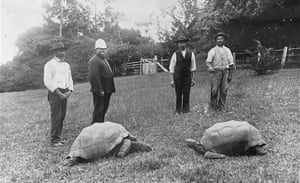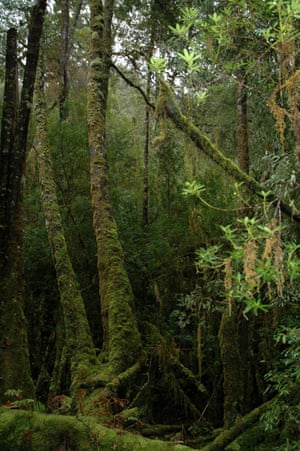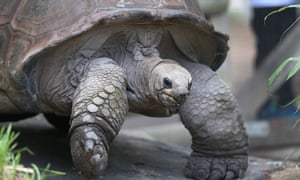They were here before us and should live on long afterwards. With 12
years to avert catastrophe, we need to imagine the aeons to come and
consider the creatures that outlive us
by Jeff Sparrow
by Jeff Sparrow
Wilbur the tortoise has, in all probability, lived more than a hundred years. Photograph: David Crosling/AAP
“From his size and weight and general health,” says Adam Lee, a reptile keeper at the Melbourne zoo, “we put him at about 110 but there’s no real way of telling with giant tortoises unless you have them from birth or as a hatchling.”
Lee holds out a carrot and Wilbur snaps at it.
He seems, in certain respects, even older than that – ancient, even prehistoric. He scrabbles on the concrete floor with ungainly dinosaur feet. When I stroke his massive shell, I can feel the scratches on the keratin. He snuffles as he eats, his leathery jaw jutting irritably, as if he were an aggrieved pensioner discussing franking credits.
Yet the idea that this creature, happily munching his carrot, predates the first world war astonishes me.“From his size and weight and general health,” says Adam Lee, a reptile keeper at the Melbourne zoo, “we put him at about 110 but there’s no real way of telling with giant tortoises unless you have them from birth or as a hatchling.”
Lee holds out a carrot and Wilbur snaps at it.
He seems, in certain respects, even older than that – ancient, even prehistoric. He scrabbles on the concrete floor with ungainly dinosaur feet. When I stroke his massive shell, I can feel the scratches on the keratin. He snuffles as he eats, his leathery jaw jutting irritably, as if he were an aggrieved pensioner discussing franking credits.
This sounds preposterous. But I already know of Jonathan, a giant tortoise estimated to have been born in 1832 but still alive and well on the island of St Helena in the South Atlantic.
The picture of him taken in the St Helena Government House grounds in the 1880s almost seems evidence for time travel. It shows four men (“good types of Saint Helenians”, according the original caption) clearly belonging to the colonial era: a portly police officer wearing a custodian helmet; a groundskeeper working in a bowler hat and a waistcoat.
And there, at the feet of those long-dead gentlemen, stands Jonathan, looking entirely the same as he does in photos from 2019.

In our times, unseasonal temperatures – even when pleasant – fill me with a vague dread. The novelist Delia Falconer discusses climate change ushering in “a new age of signs and wonders”, in which the most commonplace occurrences (a warm evening, the absence of birdlife at a particular spot, an unexpected change in vegetation) feel fraught with ecological portent.
“As the world becomes more unstable in the grip of vast and all-pervasive change,” Falconer writes, “it’s difficult to discern exact chronologies, relationships and meaning.”
More than anything, I think, climate change politicises time.
Lord Byron considered the sea “the image of eternity”. For us, however, it means flux and uncertainty, with new research suggesting the oceans could rise as much as two metres by 2100.
“Time is money,” warned Benjamin Franklin, and the extractive industries built fortunes taking him at his word. Fossil fuels depend on million-year old geological processes so that, in a sense, industrial society runs by burning natural history.
The emergence of Greta Thunberg as a global leader highlights the temporal inequity of climate change, a burden shrugged off by the old on to the young.
“[Our] future was sold,” she explained in a speech to the British parliament, “so that a small number of people could make unimaginable amounts of money.”

According to the UN Intergovernmental Panel on Climate Change, we have, perhaps, 12 years to avoid catastrophe – and one of those years has nearly passed. Yet, though we must act immediately, we need to imagine the aeons to come, planning for outcomes well beyond the threescore years and ten that scripture allots to a man.
Hence my interest in Wilbur and the other creatures whose lives extend longer than our own.
In 2007 biologists identified a 50-ton bowhead whale caught near Alaska as more than 115 years old by examining pieces of a particular harpoon stuck in its shoulder bone. Because whalers only used that patented variety of exploding lance for a brief window in the late 1880s, the fragments confirmed scientists’ suspicion that bowheads could live several centuries – providing, of course, they weren’t harpooned first.
Three years ago researchers from the University of Copenhagen dated a female Greenland shark as 392 years old.
As the Guardian’s Nicola Davis explained, that means the animal “was born during the reign of James I, was a youngster when René Descartes set out his rules of thought and the great fire of London raged, saw out her adolescent years as George II ascended the throne, reached adulthood around the time that the American revolution kicked off, and lived through two world wars”.
It’s a mind-boggling chronology, an illustration of just how wondrous our planet remains.
Yet there’s a less ennobling aspect to the story.
The oldest creatures carry marks from the people of the past and so remind us of the scars we’re already leaving on lives in the future. That becomes even more obvious when we turn from the animal kingdom to the realm of plants, the demesne in which the true ancients reside.
When I ask the Australian National University’s Dr Matthew Brookhouse, an academic and forester, about the longest living trees in Australia, he tells me that a great deal depends on what classifies as life.
“What we need to define is the age of what we’re interested in: is it the age of the organism or is it the age of the stem?”

“But what we see as the tree,” Brookhouse continues, “is really just the current aerial projection of the organism, like a potato or like a daffodil bulb. What’s lying below the ground is the longer term embodiment of that organism.”
On that basis, particular clumps of Huon pine could be said to have lived for perhaps 11,000 years, with vegetative cloning rendering the “individual” trees genetically identical.
Other forms of clonal life stretch way back into deep time. A stand of king’s holly in Tasmania has been alive for an unthinkable 43,000 years, while the Wollemi pine of the Blue Mountains west of Sydney seems to have been cloning itself for even longer.
There is, Shakespeare said, “no clock in the forest” and the Wollemi pine proves his point.
Brookhouse specialises in dendrochronology, the science of tree rings. The field itself stretches way back in history, with the ancient Greeks aware that trees produced new rings each year and Leonardo da Vinci describing the correlation between ring thickness and climate.
“Except for those very long records from ice cores, the temperature reconstructions spanning thousands of years come from tree rings,” Brookhouse says. “Much of what we know about how unusual the current temperatures are comes from trees.”
Experts described this year’s bushfires in Tasmania as “unprecedented”, with the blazes devastating some of the oldest forests in the state. King’s holly will, in all likelihood, become extinct in the wild, partly because of fires and partly from an introduced pathogen called phytophthora, something that also menaces the Wollemi pine.
Does Brookhouse feel an emotional tug when studying such ancient trees?
“Absolutely. I have a sense of quiet respect for an organism that predates us all.” He hesitates. “Actually, the emotional response to plants of that age is strongest when you see them deteriorating or when you see one die as a consequence of something we’ve done – really, in the blink of an eye, relative to the tree’s experience.”
Adam Lee expresses something similar.
The Melbourne keeper explains that the reptiles and amphibians with which he works have been hit hard by the environmental emergency, with frogs, in particular, in the midst of a mass extinction.
The giant tortoises once roamed in great herds (known, delightfully, as “creeps”) across the volcanic atolls around the Seychelles.
“I wish I could have been there,” says Lee, giving Wilbur’s long neck a rub. “It is like a dream.”
But sailors on the long voyages necessitated by the spice trade seized the giant tortoises as living meat stores, and now conservationists classify all the species as endangered.
Wilbur came to the zoo from the Seychelles in 1965, back in an era when keepers could casually swap a koala for a tortoise.
Since then, much has changed but Wilbur retains a long memory for his friends and for his enemies.
“I spent a lot of time bonding with him,” says Lee. “At the start he’d be trying to bite me and over time the aggression diminished to the point where, when I came in, he would walk over and rest his head on my arm and let me give him a little scratch. He’s much better these days but there used to be two or three keepers that he was friendly with – and with all the rest he was aggressive.”

Without question, Wilbur’s age lends him a certain gravitas. He could, after all, live for another century or more – and, because of that, he seems almost a proxy for nature as a whole, separate from humanity and yet now dependent upon us.
“We have pets and you generally know you are going to outlive your pet,” Lee says. “It is weird to think that here is another animal with which I have a bond and it’s going to outlive me. It’s humbling.”
A single reptile or an organism as massive as the Great Barrier Reef: the fates of those other lives is now entwined with our own.
Lee rubs the tortoise’s head once more.
“I am here with Wilbur now; I will do what I can to make his life positive. And then it will be someone else’s turn.”

No comments:
Post a Comment